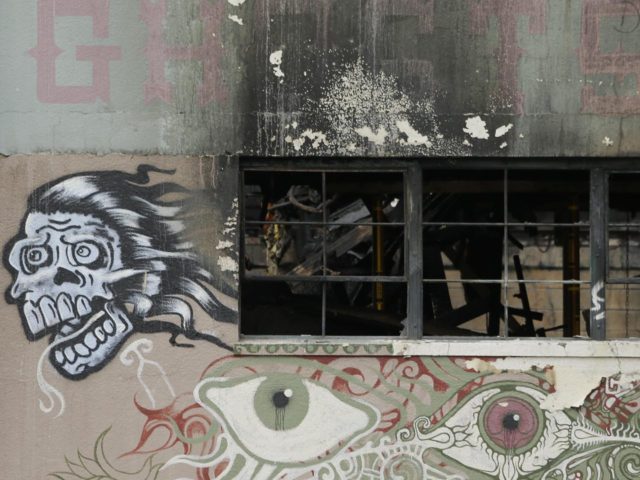The “Ghost Ship,” the warehouse and artists’ colony where 36 people lost their lives in the Oakland fire last Friday night, was “a serious attempt to bring the Black Oakland culture back into the art scene,” former resident Alexander Doré told Breitbart News.
However, that vision was overrun by what Doré referred to as the “Burning Man crowd.”
“We called it ‘the space,'” Doré said. He described himself as a close acquaintance of Derick Ion Almena, the man known as the leader of the community, and one of his wife Mika’s close friends.
“We didn’t even give it a name. It was meant to be private. None of it was for sale,” Doré said. “[Almena] wanted me to be a partner and I was brought over to the space by some local musicians and a lady who lived there because I was the third bass player in Sly and the Family Stone,” a well-known American band from San Francisco that was very popular from the 1960s through the 1980s.
Of the owner of the building, Oakland landlord Chor Ng, Doré said: “He should have applied for the permits.” The building was found to lack sprinklers and fire alarms, and the city’s efforts to inspect the premises were unsuccessful — though critics charge that local officials were lax in their duty to enforce fire codes.
“Ending up at this warehouse was part of my, I don’t want to say ‘downfall,’ but I got lost,” Doré said. He later left the community.
“I decided to say goodbye to Derick because I felt there was too much dark energy there due to the people living there,” he said, including youth that he claimed were into drugs, and who took advantage of Almena’s comparatively reasonable — although allegedly illegal — living accommodations in an area where skyrocketing rents have pushed traditional residents out.
Doré explained to Breitbart News that the vision behind “the space” was to revitalize and harness the Bay Area’s seemingly lost African-American culture.
He shared the link to a music video on YouTube by a group known as the “ROCchilds,” which might be the only documented music video filmed in the now-destroyed Oakland warehouse as a testament to this vision. (Almena and his wife have a cameo in the video at the 1:37 mark.)
Oakland and Emeryville, Doré said, “were refuges to people in San Francisco who couldn’t afford to live there anymore. So that’s creeping into Oakland. The warehouse was in the ghetto. It’s become more like Hispanic Oakland. The space was a serious attempt to bring the Black Oakland culture back into the art scene,” he said.
However, the warehouse seemed to have strayed from its original vision after an influx of what Doré described as “lost kids,” whom he called the “Burning Man” crowd, referring to the annual desert music festival.
“This place wasn’t for ‘Burning Man’ kids and entitled little drop outs and weed smoking people. These guys are serious musicians. Derick is a brilliant photographer and Mika was a friend of mine.”
It was also the lure of the reasonable rent, in an increasingly unreasonable housing market, that drew artistic youth to the compound. “The rent was about $2,500-$3,000 a month,” Doré said, although that was not what most of the warehouse’s occupants paid.
“If you had one of those campers inside it was $500 a month. Or, for $400 you could go and get your own wood and you could build you own little igloo. So what happened was, most people didn’t pay. They just defaulted and ripped [Almena] off.”
The “space” was packed with wooden furniture and included questionable electrical hookups and exposed wood throughout. There was no fire alarm or sprinkler system installed, and an unstable staircase made of wooden pallets was also the only way out of the building from the second floor.
Doré said one of the women living there, a seamstress, would go around trying to get the occupants to pay their rent. “These people were freeloaders, and Derick could not pay for the space,” which prompted Almena to host events there in order to gather funds. However, he said Almena “didn’t know how to run an event” and would often get ripped off, including by the event’s organizer on at least one occasion.
The Bay Area’s increasingly unlivable conditions also impacted Doré. “It pushed me out. My wife left me in a way because our rent went from $2,500 to $4,500, and then it went to $6,000 because of Facebook, Google, LinkedIn, and Apple people.”
He added, “San Francisco has been destroyed. There’s no way to do art unless you’re rich.”
Doré argued that the warehouse was meant to be “the antithesis of gentrification.” He said “it kind of resembled the space Derick lived in Bali and India. It was a haven in one of the worst places in Oakland, a haven in the ghetto. When you walked in you found serenity, a whole different vibe.” He added, “Even the smell from the wood made it kind of enthralling because it was an amazing, cluttered, ridiculous space. And it wasn’t designed for events.”
Following the fire, media reports surfaced about comments Almena made over his social media accounts, including a Facebook post where he said he was the “thriller love child of Manson, Pol Pot ad Hitler.”
Asked to respond to those comments, Doré said, “That’s a terrible thing to say. Derrick never murdered anybody. I think Derrick was an asshole, and he was driven by — and in a way, he would use — people that let him use them. But in terms of being a Manson, no.”
Yet he suggested some of the people who lived in the warehouse “were looking for a Manson in an odd way. I suppose they were trying to pin this on to Derick now because of what happened,” Doré said.
Follow Adelle Nazarian on Twitter and Periscope @AdelleNaz

COMMENTS
Please let us know if you're having issues with commenting.